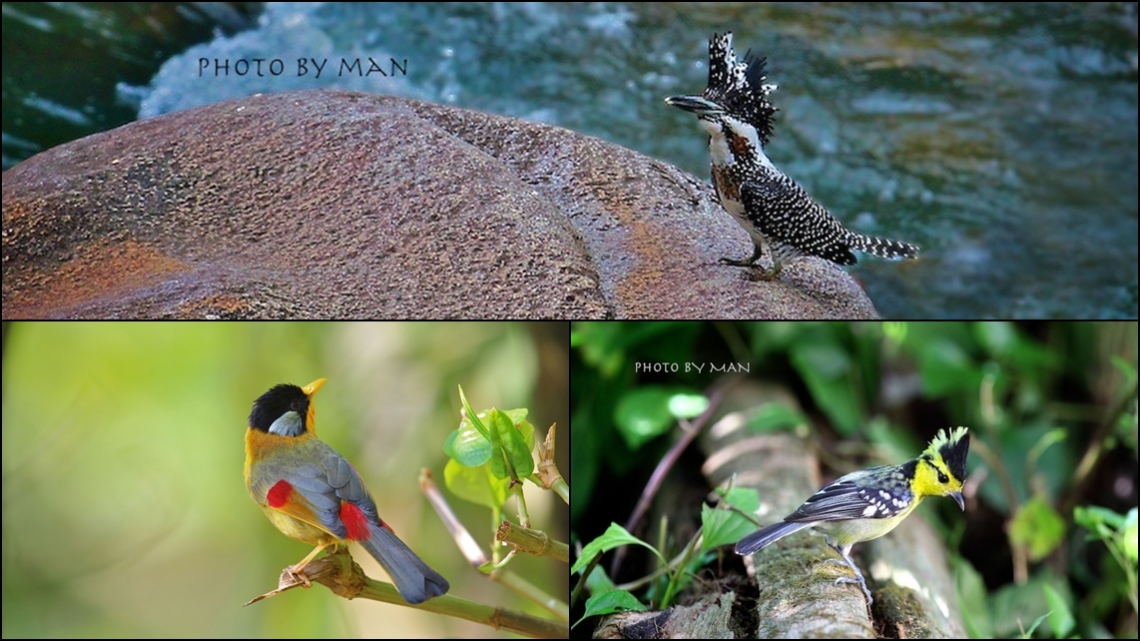Mae Wong National Park is a part of Thailand's western forest area. Its boundary is closed to Klong Lan and Klong Wang Chao National Park. Those united three pieces of forests is significantly known as "the buffer forest", so are those Tung Yai Naresuan, Huay Kha Kaeng and Aum Phang forests.
The inner area of the National Park is composed of high complex mountains lay along the lengths of Thanon Thongchai Ranges. The summit of these mountains is "Mokuju" which is 1,200-meter height above sea level. Most of the forest condition is Deciduous forest that teak forest grow alternately with evergreen forest and dry forest which naturally found in the valley and near swamps. While on the mountaintop is evergreen forest which trees are densely grow, and make the weather cool all yearlong.
Mae Wong National Park is one among those best locations in Thailand. The number of both Thai and foreign birdwatchers that visit the place is no less than 1,000 in one year. Because Mae Wong is a birding point that birdwatchers can see the most rare kingfisher of Thailand, Crested Kingfisher. Crested Kingfisher, the superstar of Mae Wong, can be found there easier than any other places, however, there are many birds those are not less attractive than it like Coral-billed Scimitar-babbler and Rufous-necked Hornbill, Burmese Yuhina.
If you would like to go farther to Chiang Mai (in the north) but your time is limit, Mae Wong is another interesting alternative.
The number of found birds in the National Park that has been discovered and confirmed is no less than 300 species of the habitats, migrants and passage migrants.
Birding & Bird Photography spot
Around the National Park Headquarters Around the headquarters' hostels those located along the winding stream which flows through the deciduous forest. Those, which mostly found are like Crested Kingfisher, Blue-winged Pitta, Greater Racket-tailed Drongo, Puff-throated Babbler, Blue Magpie, Blue-breasted Bee-eater, Golden-fronted Leafbird, Green-billed Malkoha, White-rumped Shama, Greater Necklaced Laughingthrush and, White-crested Laughingthrush.
The 82 kilometer viewpoint The forest condition on both up-hill roadsides, in front of the headquarters (since the 65 kilometer onward), is gradually changed. It is turned from Deciduous into Grass Land and Hill Evergreen forest. Besides, the temperature is get cooler according to the mountain's height. Those often found birds are such as White-throated Kingfisher, Chestnut-headed Bee-eater and Hoopoe, which are very colorful.
In some good times, you may have a chance to see Kalij Pheasant, Bar-backed Partridge and Wreathed Hornbill. At this viewpoint, there are other attractive birds especially those in Predator group like Small Acceptor and Hawks (such as Black Baza, Crested Goshawks, Besra and Crested Honey-Buzzard).
Chong Yen at the 93 kilometer Chong Yen is another interesting birding point because the forest condition is a fertile evergreen hill that is dense with many trees. All the year, the climate is comfortably cool because wind blows through the mountain's void (that is why it is called "Chong Yen" or cooling void). Chong Yen is an open area that a panoramic view can be seen, Birdwatchers can see many birds flying -come and go- for foods all day. Those that often found are like Great-Barbet, Golden-throated Barbet, Black Eagle, Bay Woodpecker, Greater Yellownape, Flavescent Bulbul, Mountain Bulbul, Minivets and many colorful kinds of them.
For here is a place of bungalow for overnight.
The route to the waterfall The route to the waterfall is a 6-7 kilometer trail for natural study. The climate is quite cool among the shady trees alternately with grassland in some parts of the hill. Those of colorful or rare birds like Coral-billed Scimitar-babbler, Red-headed Trogon, Long-tailed Broadbill, Burmese Yuhina, Grey Peacock-Pheasant, Rusty-naped Pitta and White-hooded Babbler, can be found. In some blessed days, you may see the rare and risk to extinct like Rufous-necked Hornbill flying past; or even flock of 40 - 50 Pin-tailed Pigeons, especially in winter we used to find a big flock of Chestnut Buntings in the grass field along the roadway.
Moreover, this route is the focal point of those challenge-lovers or birdwatchers who want to practice themselves in birding and classifying bird species of insect-eaters in Babblers group (kind of swift and quick-hiding birds). Those in Babblers are such as Puff-throated Babbler, Buff-breasted Babbler, Eye-browed Wren-babbler, Rufous-Fronted Babbler, Golden Babbler, Grey-throated Babbler and Striped tit-Babbler.




